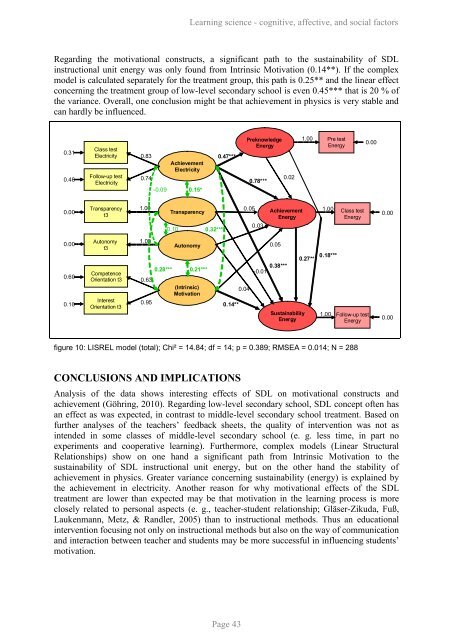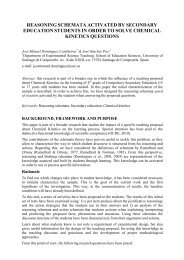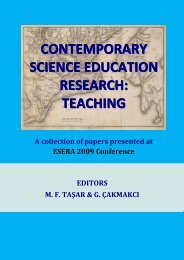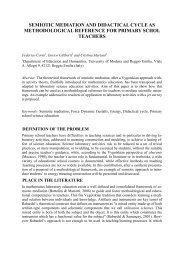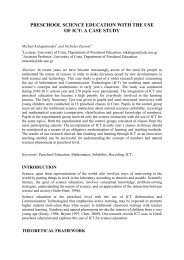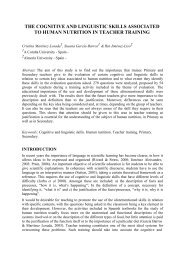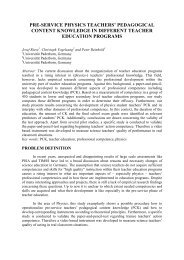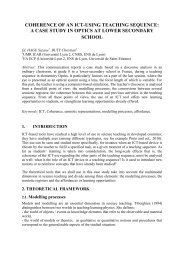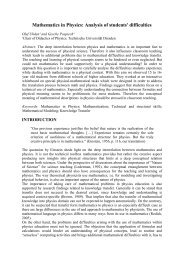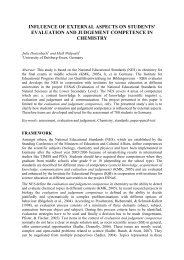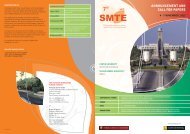Download Esera Ebook Part2
Download Esera Ebook Part2
Download Esera Ebook Part2
Create successful ePaper yourself
Turn your PDF publications into a flip-book with our unique Google optimized e-Paper software.
Learning science - cognitive, affective, and social factors<br />
Regarding the motivational constructs, a significant path to the sustainability of SDL<br />
instructional unit energy was only found from Intrinsic Motivation (0.14**). If the complex<br />
model is calculated separately for the treatment group, this path is 0.25** and the linear effect<br />
concerning the treatment group of low-level secondary school is even 0.45*** that is 20 % of<br />
the variance. Overall, one conclusion might be that achievement in physics is very stable and<br />
can hardly be influenced.<br />
0.31<br />
0.46<br />
Class test<br />
Electricity<br />
Follow-up test<br />
Electricity<br />
0.83<br />
0.74<br />
-0.09<br />
Achievement<br />
Electricity<br />
0.15*<br />
0.47***<br />
Preknowledge<br />
Energy<br />
0.78***<br />
0.02<br />
1.00<br />
Pre test<br />
Energy<br />
0.00<br />
0.00<br />
Transparency<br />
t3<br />
1.00<br />
Transparency<br />
0.10<br />
0.32***<br />
0.05<br />
0.03<br />
Achievement<br />
Energy<br />
1.00<br />
Class test<br />
Energy<br />
0.00<br />
0.00<br />
0.60<br />
0.10<br />
Autonomy<br />
t3<br />
Competence<br />
Orientation t3<br />
Interest<br />
Orientation t3<br />
1.00<br />
0.63<br />
0.95<br />
0.28***<br />
Autonomy<br />
0.21***<br />
(Intrinsic)<br />
Motivation<br />
0.14**<br />
0.04<br />
0.05<br />
0.38***<br />
-0.01<br />
Sustainability<br />
Energy<br />
0.27**<br />
0.18***<br />
1.00<br />
Follow-up test<br />
Energy<br />
0.00<br />
figure 10: LISREL model (total); Chi² = 14.84; df = 14; p = 0.389; RMSEA = 0.014; N = 288<br />
CONCLUSIONS AND IMPLICATIONS<br />
Analysis of the data shows interesting effects of SDL on motivational constructs and<br />
achievement (Göhring, 2010). Regarding low-level secondary school, SDL concept often has<br />
an effect as was expected, in contrast to middle-level secondary school treatment. Based on<br />
further analyses of the teachers’ feedback sheets, the quality of intervention was not as<br />
intended in some classes of middle-level secondary school (e. g. less time, in part no<br />
experiments and cooperative learning). Furthermore, complex models (Linear Structural<br />
Relationships) show on one hand a significant path from Intrinsic Motivation to the<br />
sustainability of SDL instructional unit energy, but on the other hand the stability of<br />
achievement in physics. Greater variance concerning sustainability (energy) is explained by<br />
the achievement in electricity. Another reason for why motivational effects of the SDL<br />
treatment are lower than expected may be that motivation in the learning process is more<br />
closely related to personal aspects (e. g. , teacher-student relationship; Gläser-Zikuda, Fuß,<br />
Laukenmann, Metz, & Randler, 2005) than to instructional methods. Thus an educational<br />
intervention focusing not only on instructional methods but also on the way of communication<br />
and interaction between teacher and students may be more successful in influencing students’<br />
motivation.<br />
Page 43


